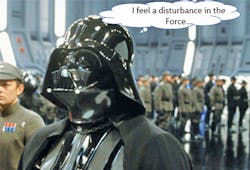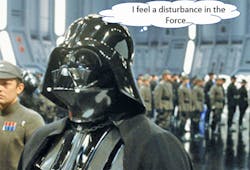Sine of the Times for BLDC Motors (.PDF Download)
With its ever-increasing electronic content, the modern automobile places a premium on energy-efficient design. That’s doubly true for hybrid-electric and full-electric vehicles (HEVs and EVs), in which the battery is the main or only source of power.
1. Should have used sinusoidal control: Torque ripple in his helmet motor confounds Darth Vader (Source: Sky.com)
The search for longer battery life has led to the increasing adoption of brushless dc (BLDC) motors over brushed designs. In traditional automobiles with internal combustion engines, BLDCs power accessories such as electric mirrors, fans for ventilation and cooling, and seat motors; in HEVs and EVs, applications expand to include former mechanical and hydraulic functions such as traction motors, generators, AC compressors, water pumps, and power-steering actuators. And let’s not forget two-wheel automotive applications: BLDCs are also making their way into motorcycle and scooter fuel-pump controls.
BLDCs have higher efficiency, higher torque-to-weight ratio, lower maintenance, higher reliability, and lower noise than their brushed motor counterparts. The downside is that they require considerably more electronic circuitry to operate.
A brushed dc motor has a wound armature (rotor) placed between the poles of a magnet
(stator), and uses the brushes to mechanically switch current to the armature and cause it to rotate—a process known as commutation. In contrast, a BLDC has a wound stator with multiple windings that surrounds a permanent-magnet rotor assembly. A controller provides electronic commutation by monitoring the rotor position and supplying power to the stator windings in the correct sequence to start and maintain rotor motion.

